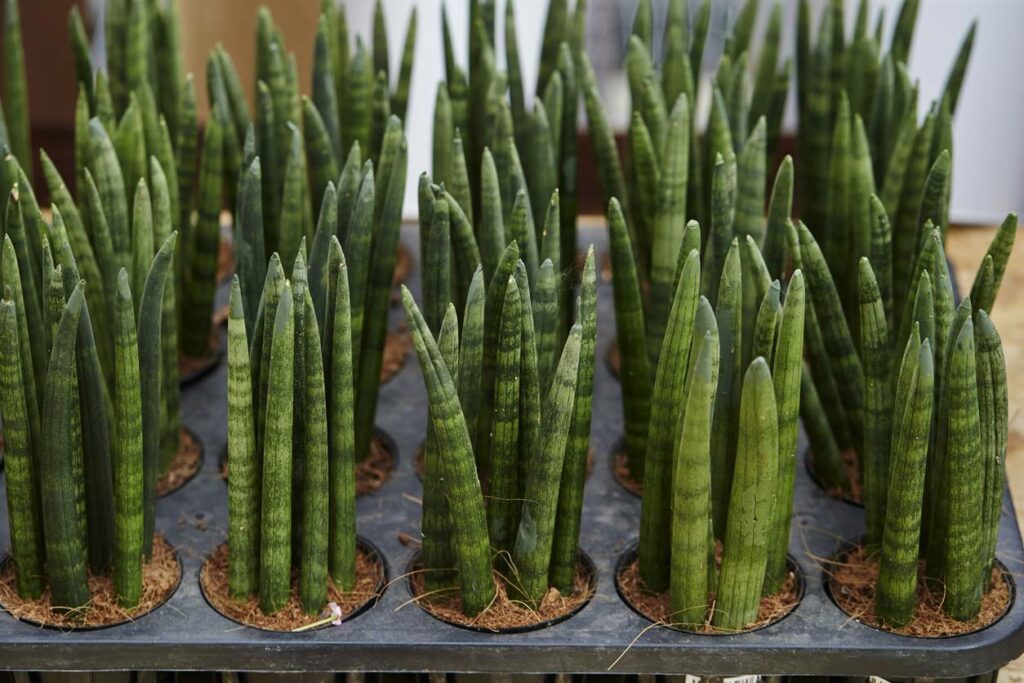Sansevieria Cylindrica Care: How to Grow & Care For The Cylindrical Snake Plant
Many households in the The states take been growing the Sansevieria Cylindrica plant over the years due to its far-ranging capacity to have the aforementioned caring and leafage yield results as those of the popular Ophidian plant. And its ability to withstand flawed growing conditions has made this multifariousness crowned equally the African Spear. One thou characteristic nigh this houseplant is information technology has stout stems that grow right from the ground, which help the leaves grow in cylindrical spears.

A Quick Look at the Cylindrica African Spear Plant
Sansevieria Cylindrica, or best known as the African Spear plant, is a perennial delicious that belongs to the Sansevieria genus which is among the members of the Asparagaceae family. This houseplant goes by quite a scattering of other names such as:
- Spear Orchid
- Skyline Spear Sansevieria
- Cylindrica Mothers-in-Laws Tongue
So how big does information technology abound? Y'all could probably enquire. Well, the elevation of most Sansevieria varieties typically ranges from 12- 24 inches every bit they arroyo their maturity stages.
Other Graceful Varieties
- Sansevieria trifasciata 'Twisted Sister': The Twisted Sister has curly leaves that abound in a warped pattern and accept a yellow lining on the edges. It'southward more than like the dwarf type amongst most other varieties since the leaves only range between 12" to 15' inches tall.
- Sansevieria trifasciata 'Golden Hanhii': The Gilt Hanhii is too popularly known equally the Bird's Nest. This variety is a petite succulent with light green stripes that run horizontally on the leaves which form a striking rosette pattern every bit they grow older.
- Sansevieria trifasciata 'Cleopatra': This cultivar is one of the all-time options for indoor spaces such as your role, room, or balcony. While information technology's hard to discover this diversity in the market, information technology's one kind of an unfussy houseplant that grows at a slow footstep but forms a striking rosette blueprint if grown under the right conditions.
- Sansevieria trifasciata 'Black Gold': The leaves of this pop perennial take golden-yellow stripes on the edges and grow sleekly tall to make the constitute look winsome in any indoor setting.
- Sansevieria trifasciata 'Futura Robusta': This is a distinct type of mothers-in-constabulary's tongue with leaves that have sleek stripes with an irregular shape. It grows compactly within a small container and makes a delightful indoor accent.
Sansevieria Cylindrica Caring Tips
Flowering & Fragrance
Snake plants bloom flowers on the base part of the leaves once they mature. During the early blooming stages, the flowers commonly appear in the course of spikes that develop in clusters. The flowers of this particular species accept a green-white color scale and are tube-shaped. At some point after blooming, the flowers will begin to die. When a shoot completes its blooming stage, new stems in the form of rhizomes sally and flare-up out new roots out of their nodes, and pour downward into the soil. Make sure to pluck off the flower stalks in one case they wither to maintain the plant's advent and verve to stay healthy. When grown outdoors, moths help out with the pollination cycle.
Soil & Transplanting
Use a quick-draining cactus mix while preparing the potting soil. Same as other succulents, Sansevierias are well-nigh often prone to root rot, so it would be best to add a portion of sandy soil to make water drain easily. Too, don't miss to use a growing pot with enough drainage holes to let out excess water. Blend the growing media with perlite to encourage aeration. You lot besides desire to use lots of organic fabric on the topsoil. Household waste such every bit banana peels and eggshells provide your African Spear plant virtually of the needed nutrients.
Some pieces of pumice and tree barks likewise add a swell ton of nutritional value to your constitute'due south potting soil. Using diatomaceous earth naturally helps get rid of pests that could potentially pose a threat to the well-being of your African Spear plant.
Low-cal & Temperature
With an upscaled potential to grow indoors, the Sansevieria Cylindrica found prefers bright, indirect light. If you're looking to place the growing pot on a windowsill, information technology'southward best to use sheer curtains so the dominicus rays can be filtered. Or better still, you can use a northward-facing window. You might also want to consider placing the growing medium under a shaded patio where chances of filtering the natural calorie-free are a fleck more than up-scaled. Information technology's worth noting that areas with low low-cal conditions will brand your plant not bloom every bit it should when the lighting is optimal. The leaves, on the other hand, won't announced brilliant. Sansevierias adopt room temperatures of betwixt 50 ° to 85° degrees Fahrenheit.
Watering & Feeding
It's quite possible for this Sansevieria diversity to survive through the dry months without being watered. When it's summertime, water it but once a calendar week and reduce the number of watering to once every month when winter checks in. When the soil is excessively wet, the roots will begin to rot. Once your African Spear plant matures, you will need to stretch out the watering intervals even further. Although it'south non a must to fertilize this delicious, you might want to feed information technology during the growing seasons, so information technology tin can yield the best leafage and bloom in the most favorable way. A well-counterbalanced fertilizer would assist it attain its peak without struggles.
Nitrogen helps your African Spear have a high-spirited growth rate, while potassium makes information technology bloom much faster. Yous also want to pick a fertilizer with phosphorus elements since they help your delicious fight commons diseases that commonly affect houseplants. During the winter months, feeding this multifariousness isn't necessary since the hormones that accelerate growth are usually numb when the temperatures are freezing.
Common Pests & Diseases
Pests
The two predominant pests you'll commonly grapple with are spider mites and mealybugs. What attracts these pests the most is the pasty sap tucked inside the leaves of the habitually grown Sansevieria varieties such equally the African Spear houseplant. In one case they suck the sap, the leaves brainstorm to wilts and dry upward entirely if the infestation is across human or chemical command. If getting rid of mealybugs seems difficult to do past manually handpicking, wipe off your found using a piece of cloth and booze. Y'all can as well raise the room humidity levels to brand the plant unhabitable for spider mites.
Diseases
The African Spear constitute volition mostly suffer from fungal diseases. One of the major causes for this status is the presence of moisture on the leaves of the plant. If you overwater your plant, the leaves might begin to develop some cerise spots. Some whitish growth might besides form on the underside of the leaves, and later turn dark-brown—making the affected areas stiffen. Fungal infections will ultimately cause your plant to die once the found begins to exhibit significant signs of rotting. To protect this houseplant from catching such dreadful diseases, always keep the leaves dry out and makes sure the topsoil is entirely before watering your establish next.
And for quick drainage, use permeable soil and keep the growing medium somewhere with normal body temperature. If you lot're growing it outdoors, it's worth noting that waterlogging your garden could cause the plant cells to flare-up. Also much water not merely causes the roots to rot—it makes the leaves bloat and produce an unpleasant scent. You want to avoid using chemicals to suppress diseases hurting the well-being of your Snake plant. These diseases are commonly caused by inconsistent watering patterns, so using pesticides would outcome in other dismaying adverse effects.
Snake Constitute Propagation
Few years after your Snake plant is fully grown, yous might find a couple of reasons to propagate information technology. This houseplant shows signs of physical deterioration one time the leaves begin to bear witness some sunburn marks, abound loosely alpine, and curve downward. In such instances, you might want to abound a whole new breed of Ophidian plants. If your Sansevieria is experiencing symptoms of root rot due to overwatering, you can still propagate it using the leafage cuttings which look good for you and have fewer blemishes. Yous would also probably want to propagate your Serpent plant since you fancy how information technology looks, and then you wish to have more than of them in your garden or balcony.
How to Propagate Your Sansevieria Snake Establish
Y'all just demand a few piece of cake tips on how to propagate serpent plants. While this plant prefers a growing medium that'south not waterlogged, developing its rooting system using water is one of the well-nigh facile methods known for yielding the best results during the whole propagation phase. For a tenable yield, yous tin can use leafage cuttings to propagate the snake plant. Don't employ leaves that look besides old or have signs of rotting. Before dissecting the leaves from the mother plant, make sure they're at least 6" inches long.
Y'all also want to continue taps with these other handy propagation tips:
- Utilize a sterilized pair of pair of scissors to dissect a few salubrious leaves from the female parent plant.
- The open up wounds demand to heal and form a callus that protects the newly propagated cuttings from communicable diseases, and then information technology's essential to place them out in the sun for a couple of days.
- Identify the base of operations function of the cuttings in a jar full of h2o and wait for the baby roots to develop.
- You can as well propagate the cuttings using soil. But remember to follow the tips right under the soil and transplanting section while preparing the potting mix.
- If you're looking to propagate them using water, transfer the cuttings in a growing medium once the pups begin to emerge.
Benefits & Uses of the Snake Plant
The African Spear, like other Snake plants, is quite an illustrious houseplant due to its capacity to purify the air. You probably know ameliorate how harmful toxins or gases such every bit benzene, xylene, and formaldehyde could cause respiratory bug when inhaled. Usually, plants release carbon dioxide at nighttime every bit they take in oxygen. So, placing most of them where yous sleep could atomic number 82 to suffocation. But that'southward practically not the instance with the Snake plant. Instead, information technology adopts the Crassulacean Acid Metabolism carbon fixation during photosynthesis to convert carbon dioxide into oxygen at dark.
And that literary means there's a constant supply of fresh air. It's no wonder why this biological belongings has over the years been used to treat Sick building syndrome. Clean air also helps become rid of foul aroma in your firm. While grooming your African Spear institute, you'll need to get rid of the dry and wilted leaves. Many skillful gardeners, nonetheless, don't throw them away. Instead, they use the dry leaves as a source of fiber which is used to make ropes and craft jewelry.
Source: https://www.diys.com/sansevieria-cylindrica/




Post a Comment for "Sansevieria Cylindrica Care: How to Grow & Care For The Cylindrical Snake Plant"